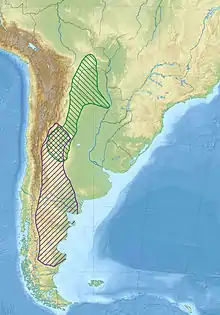Chacoan mara
The Chacoan mara (Dolichotis salinicola) is a relatively large South American rodent of the cavy family.[2] They are a close relative of the better known Patagonian mara.
| Chacoan mara Temporal range: Pleistocene–recent | |
|---|---|
%252C_Chacoan_mara%252C_Kleiner_Mara%252C_Tierpark_Berlin_Friedrichsfelde%252C_10.2012.jpg.webp) | |
| Scientific classification | |
| Kingdom: | Animalia |
| Phylum: | Chordata |
| Class: | Mammalia |
| Order: | Rodentia |
| Family: | Caviidae |
| Genus: | Dolichotis |
| Species: | D. salinicola |
| Binomial name | |
| Dolichotis salinicola Burmeister, 1876 | |
 | |
| Distribution of the Chacoan mara in green | |
Habitat
The Chacoan mara lives in the South American Chaco, the dry thorny forests and grasslands of Argentina, Paraguay, and Bolivia. Maras dig a burrow to sleep in at night.
Food and diet
The Chacoan mara eat grasses and other herbage. They will eat nearly any available vegetation.
Social structure
Chacoan maras live in small groups of up to four animals.
Scientific classification and relatives
The Chacoan mara is from the family Caviidae, which includes cavies, such as their larger relative the capybara, and guinea pigs. Chacoan maras are closely related to the other member of the genus Dolichotis, the Patagonian mara. Despite the Chaocan cavy’s close resemblance and coexistence to the Patagonian Mara, they have a broader niche to allow coexistence with its relative.[3] This flexibility is reflected by its subfamily’s high diversity,[4] recorded as early as the late Miocene epoch.[5] Maras are the fourth largest rodent in the world after the capybaras, beavers and porcupines . Though the mara may look like a rabbit, the rabbit is not actually a rodent and therefore not as closely related to the mara as one might expect.
References
- Dunnum, J.; Vargas, J.; Bernal, N.; Pardinas, U.; Ojeda, R. (2008). "Dolichotis salinicola". IUCN Red List of Threatened Species. 2008. Retrieved 22 May 2015.CS1 maint: ref=harv (link)
- Woods, C.A.; Kilpatrick, C.W. (2005). "Infraorder Hystricognathi". In Wilson, D.E.; Reeder, D.M (eds.). Mammal Species of the World: A Taxonomic and Geographic Reference (3rd ed.). Johns Hopkins University Press. p. 1555. ISBN 978-0-8018-8221-0. OCLC 62265494.
- Rodriguez, D. (2010). "Niche partitioning and coexistence between two mammalian herbivores in the Dry Chaco of Argentina". Acta Oecologica. 36 (6): 611–616.
- Madozzo-Jaén, M (2019). "Systematic and phylogeny of Prodolichotis prisca (Caviidae, Dolichotinae) from the Northwest of Argentina (late Miocene–early Pliocene): Advances in the knowledge of the evolutionary history of maras". Comptes Rendus. 18 (1): 33–50.
- Quintana, C (2005). "The caviomorph rodents from the San Andrés Formation, east-central Argentina, and global Late Pliocene climatic change". Palaeogeography, Palaeoclimatology, Palaeoecology. 219 (3–4): 303–320.
